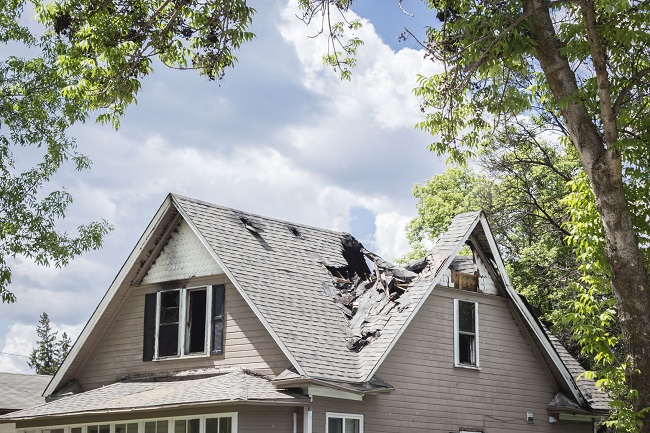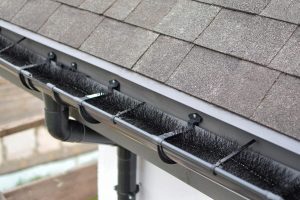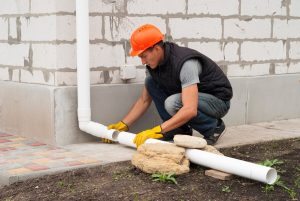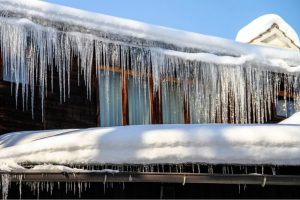When is it Time to Replace Your Roof?
Apr 25, 2023

Have you noticed brown spots on your ceiling? It could mean that there’s a leak in your roof that has caused extensive damage to your roofing material and found its way inside your home.
Regular roof maintenance is important as it helps to protect the structural integrity of your property and prevent small leaks from causing irreversible damage.
Asphalt and fiberglass shingles are often used in residential properties because they are easy to install and contain protective mineral granules that help the roofing material repel water. Roofing shingles come in different grades that have varying lifespans. High-quality fiberglass shingles can last up to 50 years with proper maintenance. To understand how long your roofing material will last, you’ll need to find out what grade of shingle was used during installation.
Consult a home inspector
First things first, get an accurate evaluation done by a home inspector. This is a critical step, especially for homebuyers. You need to get some more information on the condition of your roof. After an evaluation of the home is done, you will find out how many years are left for the roofing system to complete its service life. If the roofing is nearly approaching its service life and is already showing signs of trouble, it could be a good time to consider a replacement. In fact, old roofs can show signs of damage from the ceiling. Don’t just ignore that brown spot on the ceiling as it speaks volumes regarding the state of your roof.
Visually inspect the roof for missing shingles
You can easily notice if your roof has some missing shingles by performing a visual inspection. If multiple shingles are missing, it’s an obvious sign that there’s an issue that needs to be addressed. Missing shingles need to be urgently replaced before they can contribute to further damage. When that area is left open, it means whenever it rains, water gets directly underneath the shingles putting them at risk of mould and algae growth. Missing shingles also expose the roofing material to different forms of damage like punctures.
Watch out for missing granules
Shingles are usually coated with mineral granules that not only give them a shiny and attractive appearance but also act as a protective layer that prevents them from absorbing water. When the granules wear off, mainly due to age, the roofing shingles appear dull and flat. This is a sign of deterioration that needs to be addressed.
Curling shingles
Curling is probably the last thing you want to see on your roofing shingles. It’s usually irreversible and you’ll have no option but to replace the roof. Curling usually occurs because of ventilation issues. If the roofing was not properly installed, with ventilation in mind, curling will occur before the roof completes its full-service life. Once curling begins, you can’t go back. You must find a way to replace the roofing shingles and give it a completely new look.
Cracked and bubbled shingles
Roofing shingles can begin to crack or bubble over time. This often occurs because the shingles have deteriorated due to age. Cracked and bubbled shingles are extremely dangerous and could compromise the safety of the entire building. In fact, home repair experts advise their clients to stay away from structures with cracked and bubbled shingles.
Moss growth on the shingles
Roofs with extensive moss growth will need to be replaced. Moss grows due to the presence of moisture. If you notice this, it is a sign that your roof has been exposed to water damage. Before you do anything, it’s wise to call in an experienced roofer who will come in and first remove the moss in order to prevent the shingles from further damage.
Missing or damaged shingles
This is a common occurrence in shingle roofing. Just because one or two shingles are missing doesn’t mean that you must replace the entire roof. Keep in mind that missing shingles pose a risk to the structural integrity of your roof. To determine if you need repairs or a complete replacement, you’ll need a contractor to assess the condition of the remaining shingles. If the remaining shingles are deteriorated, bubbling or broken, you’ll probably have to consider a complete replacement.
There are homeowners who prefer replacing shingles on their own in order to save on cost. Shingle replacement is not a complex process. Just slip a flat bar under the damaged shingle to remove the nails that hold it in place. You can then pull out the damaged shingle and slip in the new one. Be careful not to damage the remaining shingles when nailing the new shingle in place. Sometimes the old remaining shingles in the area are very brittle and so you don’t have adequate room to work on the new one and ensure it fits perfectly into place.
How much will it cost to replace your roof?
Roof replacement is not a simple project that you can entrust to just any contractor that comes your way. You must get several estimates from contractors who have experience in handling roof replacement projects. Ensure that everything is included in the estimate. The cost of removing the old shingles and disposing of them should be included in the estimate.
Some contractors would want to nail down the new shingles on top of the old ones. This has changed and is never recommended by reputable roofers. In fact, this kind of installation can void your manufacturer’s warranty. Ensure that the new shingles are replaced properly even if it will mean at an extra cost.
There are a lot of factors that determine how much you are likely to pay for the new shingles. to start with, the price of shingles varies depending on where you live. If you have multiple layers of shingles on your roof, removal will cost you a lot more. The square footage of your roof and its pitch will also affect the total cost. Most importantly, the material you choose for your roofing shingles will greatly determine how much you spend. If you want to splurge on the luxury shingles, be ready to spend thousands of dollars on the roof replacement. If you’re looking at the more affordable traditional asphalt shingles, you should be able to save hundreds of dollars in installation cost.
Installing a new roofing system including the labour involved in removing old shingles can cost anywhere from $6,500 to $15,000 on a 1,600-square-foot home.
If your roof starts to show signs of trouble, you have two options to choose from: repair or replace. How do you decide the right course of action? Should you get a new roof or invest in a few quick fixes? We’ll go over a few signs that your roof needs repairs.
Common signs that your roof needs repairs
Repairs are often recommended when the roofing issue is minor, and the material underneath is still in good condition. If you’re wondering whether to call in a contractor to perform repairs, look out for the following signs:
- Just a few loose or missing shingles. You should be able to fix this with some simple repairs.
- Small leaks in certain sections of your roof. If the roof has several small spots that cause it to leak, patch them up with a sealant. Hire a qualified contractor to investigate further and determine the cause of the roof leaks. Small leaks can be caused by a bigger issue that could cause damage.
- If your gutters are sagging, you probably need a few repairs done by a contractor. Gutters sag because the fasteners that hold them in place have become too loose to handle the weight of water. Sometimes gutters sag because of poor installation. If they aren’t sloped properly, the water will not flow as fast as it should causing sagging. Sagging gutters can be replaced with new frames or just tightening the fasteners.
Common signs that you should replace your roof
If you have a bad roof that’s beyond repair, you’ll have no option but to invest in a complete roof replacement. Roof replacements can save you money in the long run because you’ll stay away from unnecessary repairs that cost you money each time. Below are some common signs that your roofing needs to be replaced:
- Your roof is old
If your roofing has or is approaching the end of its service life, you should consider having it replaced. Roofing systems can last up to 50 years depending on the material and how well they have been maintained over the years. If your asphalt shingle roofing is more than 25 years old, chances are that the repair issues are due to age. The shingles have become deteriorated and you will find yourself spending money every year on unnecessary repairs. Consider getting rid of an old roof as a great long-term investment that not only saves you on repair costs but also helps your home’s energy efficiency. You can choose a new roofing material that is more modern and able to withstand the elements better than what you had.
- Extensive water damage or leaking
Roof leaks can be a nuisance and cause extensive property damage. If you’re constantly dealing with roof leaks, it’s time to replace that roof. Hire a roofing contractor to come and perform an assessment and help you determine if the roof leaks are caused by deteriorated shingles. There’s a high chance that you’ll have to replace the entire structure if the roof leaks are too frequent and it seems to be caused by the wrong choice of roofing material or poor workmanship. If the water damage has extended to the entire structure, consider having it replaced.
- High energy bills
Is your home’s energy efficiency getting worse by the day? Perhaps it’s a roofing problem that’s causing your heating and cooling costs to skyrocket. At D’Angelo Roofing, we have replaced multiple roofing systems which have saved homeowners money in the long run. The beauty of having a modern roofing system is not only in aesthetics, but it also helps to keep your home comfortable and saves you money.
- Your roof doesn’t meet your aesthetics goal
Some people replace their roof simply because they want to enhance their curb appeal. Perhaps your existing roof is looking way off compared to the rest of your home’s exterior. If you upgrade to a new roof, you can improve the style of your home.
- You want to sell your home
If you’re planning to sell your home, replacing the roof could give you a better pay-off. Roof replacements add on to the value of the property. In fact, a new roof upgrade can greatly improve the asking price of your home at resale.
What should you expect during a roof replacement?
At this point, you’re probably excited about the idea of getting a new roof. But before you get overwhelmed with the entire process, we’re here to prepare you with what to expect. Roof replacement projects can be simple and complex at the same time. It depends on the scope of work and who will be handling the project. You must understand that there’s so much to consider and a lot of unknowns.
- Ensure you choose a reputable roofer
Most homeowners will get referrals from their friends and neighbours, search online or drive around the neighbourhood to check out signs of local roofers. However, you choose to do your search, perform due diligence prior to hiring a roofing professional.
When choosing a roofing contractor, consider the following must-haves.
- The roofer must be licensed and fully insured in your area
- The roofer must offer a warranty for their labour and materials used
- Choose a roofing professional who is transparent
- Ask for a detailed quote and ensure there are no hidden charges
- Ask the right questions
If you want to avoid disappointments at some point during the roofing process, make sure you ask the right questions. For instance, find out if the contractor will remove your old roof and how much this will cost. Ask about the installation of additional features like drip edges and an edge metal that is used to guide runoff into the gutters and prevent water leakage. Make sure you understand what grade of shingle roofing will be installed in your home and the warranty offered by the manufacturer. How about the refuse material that will accumulate as a result of the roof replacement process? Will they come with a container to deal with the trash once the job is over? Ask these questions so that you’re clear on everything and nothing comes as a surprise.
- Get the quote
Most roofing contractors don’t provide a quote over the phone. They ask to visit your property to assess the condition of your roof and then recommend a solution that’s best for your situation. When the contractor comes to your home, they’ll do a quick inspection to asses the state of the existing roof. The contractor will look out for existing problems and check out if there are any potentially difficult to work with areas. Contractors also look at the space around the home to determine if they have a slot for placing the dumpsters and supplies which will be used in the project. The contractor will also discuss the roofing material options with you and recommend what fits your needs. Once you finish this discussion, the contractor will go ahead and prepare a detailed estimate with a timeline on when the work is likely to be completed.
- Preparing your home
Once you’ve accepted the quote and the roofing contractor has given you a start date for the project, you will need to prepare your home for the roof replacement. The roofing expert will guide you on what you need to do both inside and outside your home as part of preparation. In most cases, you will be encouraged to make plans to be away from your home until the project is completed. The last thing you want is to be going in and out of the property while the work is in progress.
Part of the preparation may include:
- Moving delicate items from the property’s exterior especially the sides of your home
- Covering plants around your home to protect them from damage
- Closing the doors and windows of your home to prevent dust from getting in
- Moving furniture from the patio
- Securing items inside your home that could easily break with the slightest vibrations such as delicate artwork and breakables.
- The siding also must be protected from scratches and damage
If you live very close to your neighbours, you may want to notify them in advance of the roof replacement project. If you chose a professional roofer, you shouldn’t worry about cleanliness as they will ensure minimal debris in the neighbourhood when carrying out the reroofing process.
- Removing the old shingles
If you have roofing shingles in your home, the contractors must completely remove them in order to begin the process of re-roofing. Removing old and damaged shingles is important because it allows the contractors to inspect the wood underneath and determine if there is extensive damage and rot due to moisture exposure. If the contractor had laid new shingles over the old ones, some of these issues can easily go unnoticed. This process of removing old shingles is very important because it allows any damage underneath the wood to be uncovered and more protective measures taken in order to prevent the roof from caving in.
- Re-nailing to ensure all wood is attached
If we have some loose wooden boards on the roof, the contractor must make sure they are re-nailed so that they can handle the weight of the shingles which are going to be installed. Qualified contractors will always check for missing nails when removing shingles and wood boards. Failure to do this can cause the roof to look bumpy once the installation is complete.
- Laying down the base
Another important part of the reroofing process is where the contractors lay down the base for the shingles. It is highly recommended that the contractor installs a drip edge along the sides of the roof. This piece of metal allows for rain runoff and ensures the wood underneath is not at risk of moisture damage.
The contractor will also lay down an ice and water shield over the bottom of the roof as well as other areas such as around the chimney which are likely to be exposed to moisture. These ice and water shields are critical protective features used in modern roofs. They are designed to stick to the wood and not provide space for moisture to seep in. This guarantees maximum protection against rot. To finish off, the contractor will cover the roof with some roofing felt which acts as a barrier between the shingles and the wood.
- Shingle installation
Once the base is laid, the shingles will then be installed. Shingle installation must be done carefully to ensure they fulfill their service life. Shingles are laid by putting the nails on the overlap and placing them one at a time.
- Roof inspection
Once the roof installation process is complete, the contractor will perform an inspection to ensure everything is done up to code. The inspection will cover the most critical aspects of the installation process such as making sure the shingles are in place, nails have been properly fastened and that the roof will remain safe and secure for many years to come.
Avoid shortcuts
Roof replacement projects should be done by a qualified contractor with skill and experience in handling different materials. Don’t take a shortcut when it comes to reroofing. It’s better to hire the right people and make sure everything is done well. This is a more effective long-term solution. Contact the trusted and experienced contractors at D’Angelo Roofing to install a new roofing system in your home.





